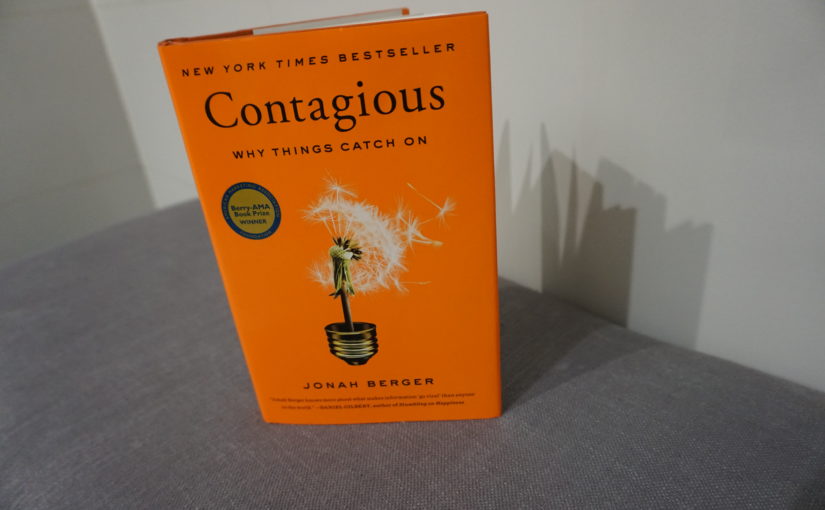I just finished reading Contagious: Why Things Catch On by Jonah Berger after completing his Lynda.com course on viral marketing. Jonah Berger is a marketing professor at the Wharton School at the University of Pennsylvania.
There are several examples of campaigns that go viral with millions of views, and Berger spent decades studying how social influence works and how it drives products and ideas to catch on.
What drew people to this ad? Why did people share it?
After going through the data, Berger and his team realized that it wasn’t random. There were very concrete reasons why people were drawn to a campaign.
Case Studies
One of my favorite case studies mentioned in the book is an ad by Google called Parisian Love. A man flies overseas to study abroad in France.

He researches how to impress a French girl, learns how to translate phrases like “you are very cute” in French and as time progresses, he finds a job in France, they get married at a church and have a child together.
This Google ad evokes strong emotion without showing a single photo of the couple. In a short time period, Google was able to give a glimpse of an international love story between a man and woman, all through search terms, translations, and map requests typed into the Google search bar.
Kit Kat and Coffee

It is hard to think of the word peanut butter without also thinking about the word jam. One way to find marketing success is to link your product or idea with another concept that will trigger people’s memories.
Kit Kat rolled out an ad campaign named “Kit Kat and Coffee.” Coffee was a good frequent trigger that would make people remember the brand because people have coffee every morning. This campaign increased sales and rebooted the brand.

Corona also successfully used triggers by associating their Mexican beer with beaches. Their ads have no words. It’s simply two people lounging on a beach with a Corona in hand, the soft crash of the ocean waves and seagulls chattering.
These ads make you want to be there, sitting on the sand, and also remind you to have a Corona when you get there.
Dove’s Evolution
Advertising and the media has taught young women that something is wrong with them, that women need fixing. In every women’s magazine there are glossy pages of skinny women with bright lipstick, full lashes and tousled hair.

Dove’s Evolution starts its ad with a woman who looks very ordinary. Throughout the video she receives layers of makeup and hair styling. At the end, the photographer air brushes her image in Photoshop to make her look flawless by lengthening her neck, enlarging her eyes and plumping her lips.
The words appear, “No wonder our perception of beauty is distorted. Take part in the Dove Real Beauty Workshop for Girls.”
Dove’s Evolution is a Storytelling Trojan Horse because it sparked women’s conversations about real beauty and false images of women being advertised, all the while carrying the brand name of Dove along the way.
 Movember
Movember
One great example of making the private public is Movember.
Men started growing mustaches that never had them before, and if you asked them why then they would tell you they were growing them to raise funds for prostate cancer awareness.
After raising $54,000 for the Prostate Cancer Foundation of Australia, The Movember Foundation grew to include more countries, and now every November men pledge to raise awareness and money by growing mustaches.
Fighting prostate cancer is a cause that is hard to see when others are participating, and Movember made it visible.
STEPPS to Viral Marketing Success
Social Currency – Does talking about your product or idea make people look good? Can you make people feel like insiders?
Triggers – What cues make people think about your product or idea? How can you make your product come to mind more often?
Emotion – Does talking about your idea or product generate emotions? How can you kindle the fire?
Public – Does your product or idea advertise itself? Can people see when others are using it? If not, how can you make the private public?
Practical Value – Does talking about your product or idea help people to help others? How can you highlight incredible value, packing your expertise into useful information others will want to share?
Stories – What is your Trojan Horse? Is your product or idea embedded in a broader narrative that people will want to share?
Going Further
Contagious took a magnifying glass to the reasons why people share certain content and it deconstructed the components of a successful marketing campaign.
Both the book and the Lynda.com course are worth viewing if you are a marketing professional or company leader interested in creating more awareness of your brand.
The American Marketing Association named Contagious a winner of the Berry-AMA Book Prize award.
The Lynda.com course is also listed in the preparation material for the American Marketing Association’s PCM Certification Test for Content Marketing.
